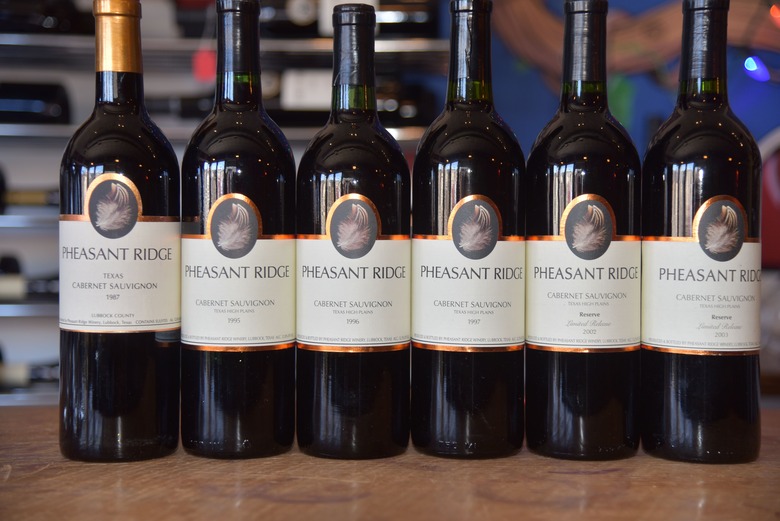Can Texas Produce Age-Worthy Cabernet Sauvignon?
Cabernet sauvignon is legendary for its ability to improve in the bottle, often for more than a decade, and then to remain enjoyable for many more years after that. There are many examples from Bordeaux and California's Napa Valley. But if cabernet is grown outside one of its recognized centers of excellence, does it still mature gracefully? A recent vertical tasting of Pheasant Ridge Cabernet Sauvignon, obtained directly from that Texas winery, offered a rare chance to go back not just 10 or even 20 years, but nearly 30 to see how the wines fare with age.
The world's most influential wine critic, Robert Parker, has noted that "for cabernet sauvignon Pheasant Ridge Winery is turning out lush, intense wines with plenty of character that can compete in quality with anybody." Nonetheless, 30 years is far beyond what 99 percent of the wines in the world can manage, and, frankly, many cabernet producers would be delighted if their wines survived for just a decade.
To bring a range of palates and sophistication to the exercise, I assembled a panel of nine wine professionals at Wine Poste And Bar Anatomie, one of Dallas' most hands-on wine retailers. All were sommeliers, except myself and the general manager of Wine Poste, Wes Dorlich. On a bitterly cold Saturday afternoon, we sniffed and slurped our way through six vintages, from 1987 through 2003, of Pheasant Ridge's flagship cabernet sauvignon from the winery's estate vineyard. The cabernet is Clone 7 grown on various rootstocks (AXR, 5C, self-rooted, etc.); the wine was aged in Allier oak from Seguin Moreau and Boutes. The wines were not blind-tasted, since recognition was not the objective. Each taster used his scoring system of choice, with the proviso that they rank the wines in order of preference.
First up was the oldest wine, the 1987, made by winery founder Bobby Cox. This wine was so old, in fact, that its appellation was Lubbock County, as the Texas High Plains AVA (American Viticultural Area) did not yet exist until 1993. The tasters all thought that the wine showed unmistakably as old. They noted its opaque brown core and tawny rim. Several referenced dried fruit. Wine educator Mike Lanese noted dried apricot and prunes and Chad Hoes, Certified Sommelier and Certified Specialist of Wine, alluded to its "stewed, prune nose." Nonetheless, there were positives. The taster who ranked the wine highest, Wine Poste's Wes Dorlich, summarized it as "still holding on, still good," and Aaron Benson, beverage manager at 60 Vines in Plano, found it had "impressive intensity and acidity."
Next, we moved to a wine eight years younger, the 1995, this one under the Texas High Plains AVA and made, as are all the wines below, by Pheasant Ridge winemaker Manuel Lechuga with Southern California-based consultant Enrique Ferro. Unfortunately, the wine was corked, a flaw most noticeable on the nose. Advanced Sommelier Luis La Torre looked past it to note that, on the palate, the wine showed "a great balance of fruit, tannins, and acidity. The fruit still present showing some figs." This suggested that had we tasted a bottle that had not been corked, this could have been a high-scoring vintage.
The 1996 redeemed the wine, with Jeff Andrus, vice president of Zerbina Imports, describing it as "pretty" and showing "dried fruit, baked apple sweetness" with a "sweet blueberry finish." It was Certified Sommelier Tim Carruthers' second-favorite wine, and he noted "green olive, tobacco, cherry, cinnamon, coffee, and leather."
The next wine, the 1997, was my favorite. It had a color of light red brick, with ripe red fruit and cedar on the nose, and soft red fruit and anise in the mouth. Advanced Sommelier Steve Murphey also found this to be his favorite and noted that, on the palate, it had mushroom, medium tannin, Red Delicious apple, and a tart finish.
The final two wines moved us into the present century. The 2002 Reserve was the panel's overall top-ranked wine. Carruthers noted that the nose had notes of cedar, tobacco, leather, and black plum. Hoes found the mouth very balanced, with good acid and tannins. The fruit was red and black cherry and cranberry. Both of these tasters ranked this as their favorite wine.
The 2003 Reserve did not fare so well, with Dorlich finding it "hot" and Murphey describing the flavors as tart. This did not detract for Lanese, who noted the plum and cherry notes and placed the wine first in his ranking.
The final rankings, from most- to least-liked, were: 2002 Reserve, 1997, 1996, 2003 Reserve, 1987, and 1995.
My overall thoughts on the markers for Pheasant Ridge Cabernet Sauvignon in this era were long-lived red fruit; firm (and sometimes silky) but not aggressive tannins (I was impressed how the tannins stood up with time); cedar notes in the nose, giving the wines a Bordeaux character; and intense color, though these are not over-extracted fruit bombs. In general, they showed a formidable ability to age in the bottle, particularly impressive for wines made so early in Texas wine history. They also showed the inaccuracy of the commonplace that "Texas needs to grow Mediterranean grapes." The truth is more nuanced. Good winemaking and viticulture can overcome climatic conditions.
Bobby Cox took back the winemaking seat at Pheasant Ridge as of the 2015 vintage, and it will be interesting to see how the new wines taste.
